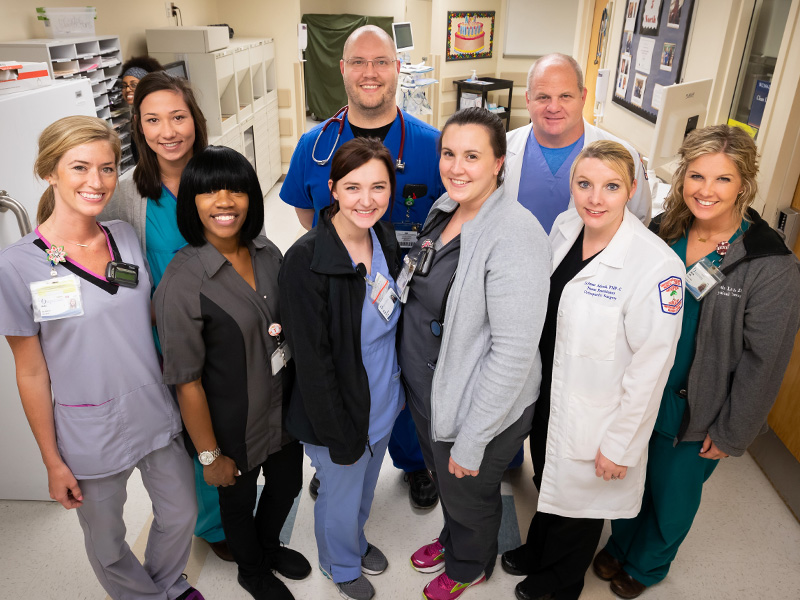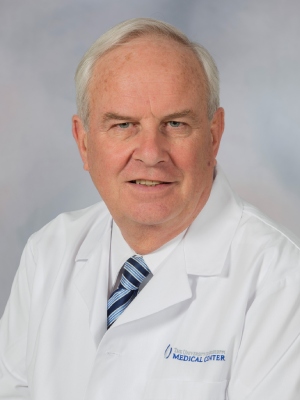Frontline team effort spurs improved patient safety scores

Frontline caregivers at the University of Mississippi Medical Center are taking ownership over keeping patients safe from harm, and their good work is showing.
That ongoing effort to drive a culture of safety has boosted the Medical Center’s score from a private hospital ratings group this year to “C” for its overall performance on factors that result in patient harm.
The higher grade, made public Tuesday by The Leapfrog Group, validates the Medical Center’s work to drive change and make measurable progress in patient safety since 2015, when quality improvement became UMMC’s top strategic priority.
“Each time they’ve reported, we’ve taken another step forward,” said Chief Medical Officer Dr. Michael Henderson. “This is further validation of the excellent work being done by our health care provider teams that have worked on improving patient safety. They took this to heart, and they deserve a lot of credit for the improved score.

“We have made significant progress since the ‘F’ of October 2015, but the work is not done,” he said. “This is an ongoing journey.”
Leapfrog twice annually uses data that’s up to four years old to calculate a hospital’s A-F letter grade, meaning critical improvements made at UMMC over the past several years are still catching up with the latest score. That includes significant gains over the past year alone.
“It’s nice to have external validation (from Leapfrog) of the improvement we’ve been seeing over the past two years,” Henderson said. “We are just beginning to see published data from our improvement work that is then used by Leapfrog. I anticipate that over the next two years, it will continue to improve and move us up” on Leapfrog’s scale.
The Medical Center, in laying new groundwork for performance improvement, hired Henderson in spring 2015 from the Cleveland Clinic, where he served as chief quality officer. Since then, he and the Medical Center have engaged front-line staff and leadership at all levels as part of UMMC’s pledge to keep improving. Henderson is a transplant surgeon and hospital performance expert.
UMMC Grenada, one of two community hospitals of the Medical Center, kept the “F” rating it was assigned in fall 2017. The Grenada hospital, licensed for 156 beds compared to UMMC’s almost 700, “found itself in a similar position as that of the main campus two years ago,” Henderson said.
“It’s taking steps to get on the same path to improve patient safety. We anticipate seeing a similar trajectory there to what we are seeing here.”
How Leapfrog determines scores, as well as the methodology behind ratings given from the federal Centers for Medicare and Medicaid Services, CMS for short, has come under fire from national hospital organizations that say those groups don’t adequately risk-adjust for socio-demographic challenges faced by academic medical centers such as UMMC that serve large numbers of disadvantaged and very sick patients.
UMMC is the state’s safety net hospital, meaning it cares for the sickest of the sick, regardless of their income. Mississippi’s only Level I trauma center and the state’s only children’s hospital are both located at the Medical Center’s main Jackson campus.
The Medical Center has taken a number of steps toward transparency in releasing year-to-year and month-to-month data, both internally and for the public. That drives improvement in all focus areas by holding front-line employees such as doctors and nurses accountable for their performance.
Henderson has bolstered the Medical Center’s communication and relationship with UMMC’s governing board, the State Institutions of Higher Learning, giving its members frank and up-to-date information on the hospital’s performance and progress.
And in March, UMMC rolled out “Chasing Zero,” an initiative that strives to eliminate serious safety events impacting patients and to cultivate safer, more effective care. The initiative is modeled after “Zero Patient Harm is Achievable,” an effort championed by The Joint Commission, the nation’s leading accrediting body in health care.

Chief Nursing Officer Dr. Terri Gillespie is responsible for setting the safety tone for the Medical Center’s approximately 3,000 nurses. “Research has shown that when patients are admitted to a hospital, their expectation is that we will do no harm,” Gillespie said.
“Research also shows that developing an infection is one of their top 10 fears. We need to live up to their expectation of doing no harm and to alleviate any fears.”
Leapfrog bases its letter-grade ratings on a total 27 metrics. Half of them focus on safety and use CMS data such as rates of infection, pressure ulcers, hand hygiene and complications after surgery, and systems in place to address them. Some others are based on non-safety processes, such as patient experience. Leapfrog takes information from the 80-plus metrics that all hospitals are required to report to CMS and that are published on the federal Hospital Compare website.
Leapfrog builds into scores 12 metrics from its own survey, voluntarily completed by hospitals, which in part address leadership engagement in effecting change. Although about 60 percent of the nation’s hospitals choose not to self-report that data, UMMC does as part of its commitment to transparency.
Nurses and nurse practitioners, doctors and surgery staff represent only a few of the groups that provide bedside care to a growing number of patients at the Medical Center, where almost all beds in the hospitals and intensive care units are full on a daily basis.
“We have changed the perception of how patient safety and quality are addressed, and we have a leadership responsibility to make sure we are giving guidance, resources and feedback to front-line caregivers who do the work,” Henderson said.


